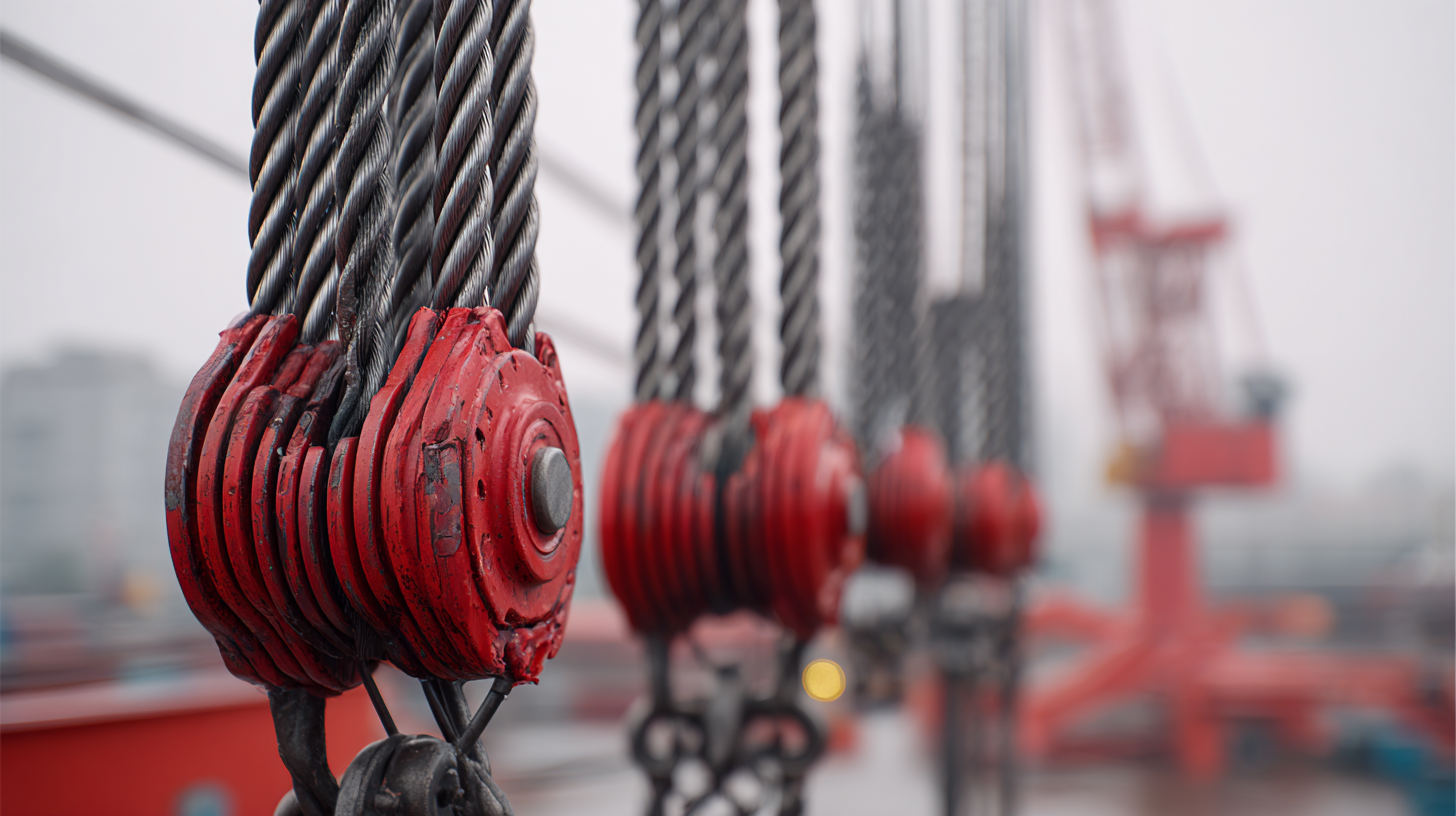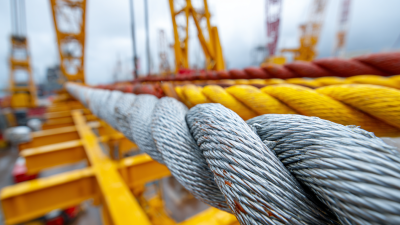How to Choose the Right Crane Hoisting Wire Rope for Optimal Lifting Efficiency and Safety
Choosing the right Crane Hoisting Wire Rope is crucial for ensuring optimal lifting efficiency and safety in various industrial applications.
A properly selected wire rope not only enhances the performance of crane systems but also minimizes the risks associated with lifting operations.
With numerous options available in the market, it can be a daunting task to determine which wire rope will best suit your specific needs.

Factors such as rope construction, material, diameter, and load capacity must be carefully considered to ensure that the crane operates smoothly and safely under varying lifting conditions.
In this guide, we will explore the key aspects to consider when selecting Crane Hoisting Wire Rope, offering insights into how to make informed choices that align with both safety standards and operational efficiency.
Whether you are involved in construction, manufacturing, or any other lifting-heavy industry, understanding these principles will help you maximize productivity while safeguarding against potential hazards.
Understanding Different Types of Crane Hoisting Wire Ropes for Your Needs
When selecting the appropriate crane hoisting wire rope, it is crucial to understand the various types available and their specific applications. Wire ropes are typically categorized based on their construction, material, and intended use. For instance, traditional steel wire ropes are favored for their durability and strength, making them suitable for heavy lifting operations. On the other hand, synthetic wire ropes have gained popularity due to their lightweight nature and resistance to corrosion, ideal for less demanding environments.
Each type of wire rope possesses unique characteristics that can significantly affect lifting efficiency and safety. The construction of the wire rope, such as the number of strands and wires, influences its flexibility and load capacity. Additionally, the coating or treatment applied to the wire rope can enhance its lifespan and performance in harsh conditions. It is essential to analyze the specific requirements of your lifting scenario—such as load weight, lifting height, and environmental factors— to determine the most suitable wire rope that ensures optimal safety and efficient operation for your crane system.

Key Factors to Consider When Selecting Crane Hoisting Wire Rope
When selecting crane hoisting wire rope, several key factors must be considered to ensure optimal lifting efficiency and safety. First and foremost, it's essential to evaluate the rope's material, which typically includes steel or synthetic options. Steel wire ropes are highly durable and suited for heavy lifting applications, while synthetic ropes offer lightweight alternatives that can reduce wear on equipment. The specific lifting conditions, such as environmental factors and load types, also play a critical role in material selection.
Another important consideration is the rope's diameter and construction design. A thicker rope generally has a higher load capacity; however, it may also add weight and affect maneuverability. The construction type, whether it's a 6x19 or 6x36 configuration, influences flexibility and resistance to crushing. Furthermore, always account for the rope's tensile strength, fatigue resistance, and compatibility with existing cranes to optimize performance and safety. In addition, knowing the manufacturer's specifications and adhering to industry standards can significantly enhance the selection process, ensuring that the wire rope chosen will withstand the demands of its intended application.
Assessing Load Capacity and Safety Ratings for Wire Ropes
When selecting wire ropes for crane hoisting applications, assessing load capacity and safety ratings is crucial for optimal lifting efficiency. According to the American Society of Mechanical Engineers (ASME), wire ropes used in lifting applications should have a safety factor ranging from 5:1 to 7:1, depending on the conditions and nature of the lift. This means that if a wire rope is rated for a specific load, it should be able to handle five to seven times that load under optimal conditions, ensuring reliable performance and safety during operations.
Moreover, the Wire Rope Technical Board (WRTB) recommends evaluating the diameter, construction, and material of the wire rope to ensure it meets industry standards for strength and durability. For instance, a #6 wire rope (with a diameter of about 0.25 inches) may have a breaking strength of approximately 3,500 pounds, making it suitable for light-duty applications. In contrast, for heavy lifting tasks, a #12 wire rope could exceed 15,000 pounds in breaking strength, providing the necessary safety margin. By considering these factors and adhering to established guidelines, professionals can make informed decisions that enhance both efficiency and safety in crane operations.
Wire Rope Load Capacity and Safety Ratings
This chart illustrates the load capacity (in tons) and safety ratings (in factor of safety) of different types of crane hoisting wire ropes. Choosing the appropriate wire rope based on load capacity and safety ratings is crucial for optimal lifting efficiency and safety.
Maintenance Tips to Ensure Longevity and Performance of Wire Ropes
To ensure the longevity and performance of crane hoisting wire ropes, regular maintenance is crucial. Operators should conduct thorough inspections before each use, looking for signs of wear, fraying, or corrosion. Catching these issues early can prevent failures that could lead to accidents or costly downtime. It’s important to check for kinks and twists in the rope, which can alter its structural integrity.
Additionally, lubrication plays a vital role in maintaining wire rope function. Using the appropriate lubricants minimizes friction and protects against environmental factors like moisture and debris. Operators should also ensure that the ropes are stored correctly when not in use, avoiding excessive exposure to harsh conditions.
Following these maintenance tips can enhance safety and extend the service life of wire ropes, optimizing lifting efficiency in the long run.
Common Mistakes to Avoid When Choosing Crane Hoisting Wire Rope
When selecting crane hoisting wire rope, it's essential to be aware of common mistakes that can jeopardize lifting efficiency and safety. One of the most prevalent errors is underestimating the load capacity required for the job. Always ensure that the chosen wire rope has a rated capacity that comfortably exceeds the maximum load you expect to lift. This precaution helps to prevent accidents and equipment failure.
Another mistake to avoid is neglecting the environmental factors that can affect the wire rope's performance. For instance, exposure to corrosive substances, extreme temperatures, or abrasive conditions can weaken the rope over time. Be sure to select a wire rope that is specifically designed for the environment in which it will be used.
Tips: Regular inspections can help identify wear and tear before it becomes a serious issue. Additionally, pay attention to the wire rope's construction — options like plastic-coated wire ropes can offer extra protection in harsh environments. Lastly, always consult with manufacturers or experts to ensure that you're choosing the most suitable wire rope for your specific lifting needs.

Home
About Us
Products
Stainless Steel Anchor Chain
Manganese Steel Lifting Chain Grade 80
Manganese Steel Lifting Chain
Hastelloy Round Bars
Hastelloy Sheet
Hastelloy steel pipe
Stainless steel wire rope
Stainless steel round
Stainless steel hexagonal rod
Stainless steel strip
Plastic coating wire rope
Stainless steel plate
Stainless steel angle
Stainless steel pipe
Stainless steel wire
Stainless steel flange
Stainless steel channel
Stainless steel flat steel
Industries
News
Service
Blog
Contact Us








